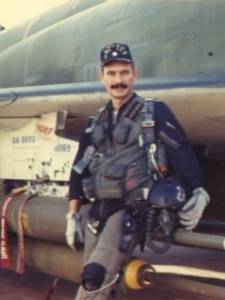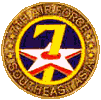|
Stanley Scott Clark
Colonel
497TH TAC FTR SQDN, 8TH TAC FTR WING, 7TH AF United States Air Force Modesto, California May 22, 1928 to February 14, 1969 STANLEY S CLARK is on the Wall at Panel W32, Line 31 |
  |

|



| |
|
Our dad was a Lieutenant Colonel USAF, a pilot flying an F-4 Phantom shot down on a day when people celebrate love
It was a day we did not celebrate for many many years. Our dad was shot down over Laos. His target was a rock quarry which could be rebuilt by 1000 Vietnamese in one day. He died that day maybe, maybe not. No one could prove he did die that day. Chances are he made it. Who knows? No answers, no closure. Life goes on? Yes it does but not without missing someone so much that your only memory after so many years is a photograph, no stories to tell. The only comfort is in knowing that we will see each other again one day. Then we will know the whole story.
Until then, DAD,
Karen Reed |
|
I'm Dale R. Miller. I've had Colonel Clark's POW Braclet since approximately 1970. I got it in San Diego, at a Vet's booth during a Veteran's Day celebration. I wear it every Veteran's Day. I was a crew-chief on C-130's at Ton Son Nut AFB (1964-1965), on temporary duty from Anderson AFB. Was a Bomber troop (B-47). Returned to Bunker Hill AFB, Indiana, as crew-chief (B-58). 25 years in civil service as a Aircraft Mechanic. Retired 1997 in Corpus Christi, Texas. I have had the honor of having this bracelet all these years, it was the first one I got. I have two others: SPEC 5 Joe Puggi and Lawrence Stark. God bless him, and he will NEVER be FORGOTTEN by me or my fAMILY.
Sincerely,
From The Virtual Wall: |
|
My name is Ray Yancey and I live in the greater Cincinnati area. I too have one of Colonel Clark's MIA bracelets. I've had it for 30 years or more and it will remain one of my treasured possessions unless requested by someone whose care is more deserving than mine. Colonel Clark was lost when I was a senior in high school, safe at home while he gave his life (perhaps) to make sure I stayed that way. I salute his courage and dedication.
Ray Yancey |
|
I also have one of Colonel Clark's MIA bracelets. I was 19 years old in 1969. The bracelet has been kept in a jewelry box for many years, and each time I looked at it, I would once again pray for him and his family. God bless all of you.
Sherryl Evans |
Notes from The Virtual WallOn 14 February 1969 LtCol Stanley S. Clark was the section leader for a flight of two F-4D PHANTOM aircraft from the 497th Tactical Fighter Squadron based at Ubon RTAFB, Thailand. The section was tasked with a night strike mission in southern Laos near the border of Vietnam.Clark's plane was hit by anti-aircraft fire while over the target. He climbed to about 12,000 feet and ordered his backseater to eject. As the backseater ejected the plane began a rapid descent, passing through a cloud layer at about 10,000 feet before breaking into the clear below the cloud layer. The aircraft was observed to impact in a river valley near the town of Ban Bac in Saravane Province. Although radio contact was established with the copilot, there was no contact with LtCol Clark nor was a second parachute observed. A Search and Rescue force of four SANDY A-1 aircraft and two helicopters launched from Nakon Phanom RTAFB at 0500 15 February. On arrival, LtCol Richard A. Walsh of the 602nd Special Operations Squadron, 8th TFW, became on-scene commander. LtCol Walsh and his wingman began a search pattern over the area while the second section of A-1s and the helos held clear. Walsh established radio contact with the downed pilot, called in the helicopters to pick him up, and reported receiving ground fire. Other aircrew observed muzzle flashes and 37mm anti-aircraft shell bursts fire behind Walsh's aircraft and along his flight path. No further transmissions were received from Walsh, no parachute was seen, and no emergency radio beeper signals were heard. After the downed pilot was recovered he stated that he heard an anti-aircraft site open fire as Walsh's aircraft approached and shortly thereafter heard the the A-1 explode on impact. He estimated that less than 15 seconds elapsed between the AAA fire and aircraft impact. Dense jungle foliage prevented him from actually observing the incident. Further SAR efforts were not successful in locating either LtCol Clark or LtCol Walsh and both men were initially were classed as Missing in Action. After considering all available evidence, an Air Force board concluded that LtCol Clark had died in the incident. LtCol Walsh was continued in MIA status until 04 October 1979, when a Presumptive Finding of Death was approved by the Secretary of the Air Force. As of 05 March 2008 the remains of Stanley Clark and Richard Walsh have not been repatriated. The POW Network bio pages for LtCol Clark and LtCol Walsh contain additional information, including the statement that "The area in which Clark and Walsh were lost was recaptured by friendly forces about three months later" and that the wreckage of both aircraft was located. The POW Network goes on to say that (1) Clark's ejection seat was not in the wreckage of the F-4D and (2) Walsh's remains were not found in the A-1 SKYRAIDER wreckage. While it was common practice to insert ground teams whenever possible to search the wreckage of downed aircraft in an effort to recover aircrew remains, the area around Ban Bac, Laos, comprised part of the Ho Chi Minh Trail and remained solidly in the hands of the North Vietnamese Army; the area was never "captured" by US or ARVN forces. The POW Network does not offer any documentation for the statements cited above. |
| Contact Us | © Copyright 1997-2019 www.VirtualWall.org, Ltd ®(TM) | Last update 08/15/2019. |